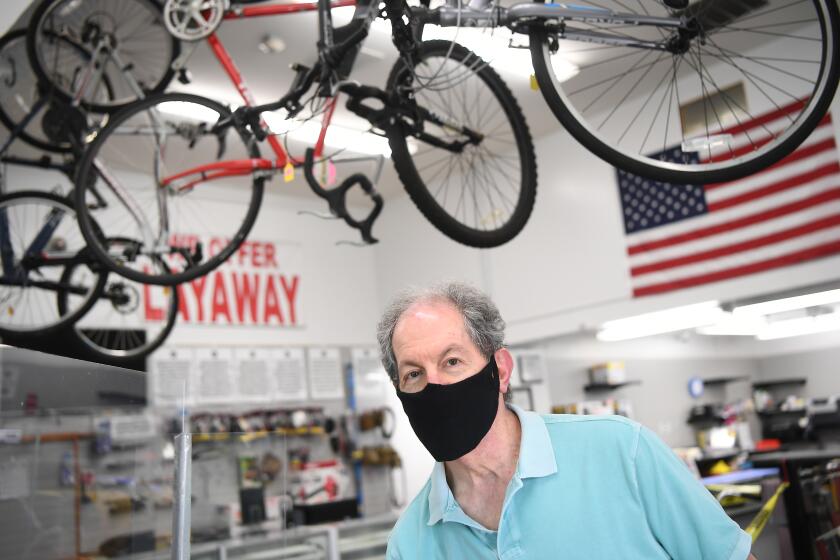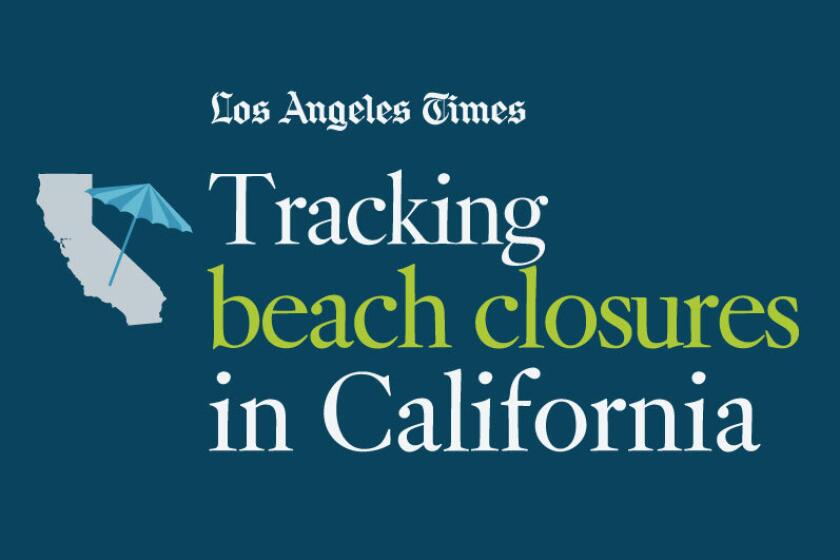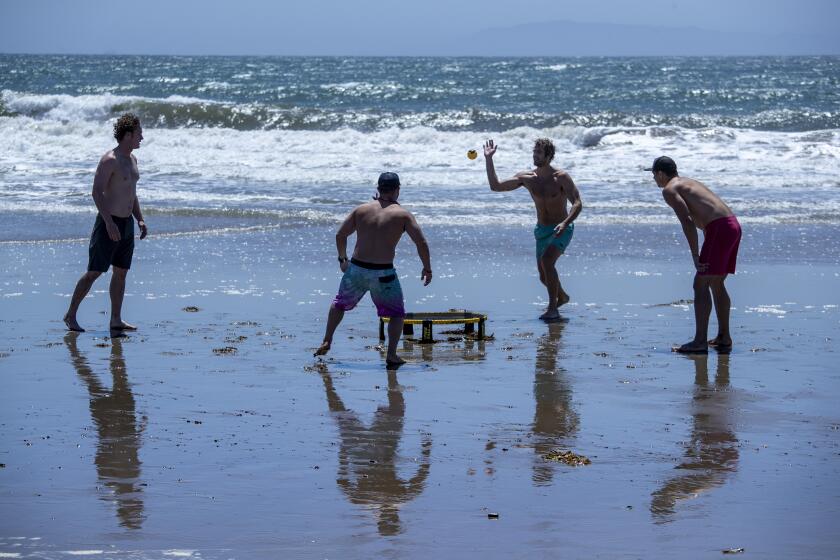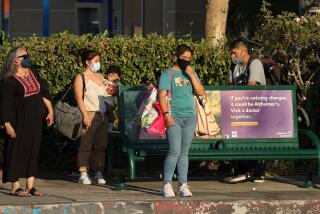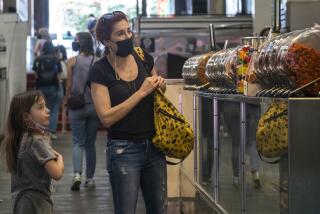Masks will be mandatory at LAX and on city buses beginning Monday

The requirement announced by L.A. Mayor Eric Garcetti came hours after county officials laid out the first steps to easing stay-at-home orders.
- Share via
Beginning Monday, anyone traveling through Los Angeles International Airport must wear a mask or face covering.
The new requirement announced Wednesday evening by Mayor Eric Garcetti came hours after L.A. County officials laid out the first steps toward easing stay-at-home orders imposed almost two months ago. Those restrictions have been credited with slowing the spread of the coronavirus throughout Los Angeles and the region.
Florists, car dealers and various types of bricks-and-mortar stores — including those that sell toys, music, books, clothing and sporting goods — will be allowed to open for curbside pickup only starting Friday. In-store shopping will not be permitted.
“This list is less about what products are sold and more about the ability to maintain social distancing,” county Supervisor Kathryn Barger said.
Recreational amenities including golf courses and trails under county jurisdiction will also reopen Friday. People still must adhere to physical distancing requirements and wear face coverings when they’re in proximity to others.
It’s not much, but Los Angeles County has announced the first steps in easing stay-at-home rules that have slowed the spread of the coronavirus.
Health officials on Wednesday outlined for the first time a five-stage plan for reopening L.A. County. Though the first retailers will be permitted to reopen with conditions this week under Stage 2, the county hopes to soon allow other low-risk business — including manufacturers, offices and larger retail — to also open their doors.
Stage 2 also allows for the reopening of libraries, museums, cultural centers and galleries. The county has not provided a proposed date when those spaces could again be accessible.
Los Angeles County beaches will remain closed for the time being, despite other coastal stretches reopening — with limitations — this week in nearby Orange County with the state’s blessing.
Officials are working on a plan that will allow for the “slow reopening” of L.A.’s coastal stretches, said Barbara Ferrer, director of the county’s Department of Public Health.
“I know we can all look forward to that happening pretty soon,” she said.
Stage 3 of the county’s plan includes businesses deemed to be at higher risk, including tattoo shops, massage parlors, bars, movie theaters, bowling alleys and schools. Stage 4 includes the highest-risk businesses, such as entertainment venues hosting concerts as well as large conventions and sporting events.
At Stage 5, all businesses will be considered to be operating as normal. County officials did not provide a timeline for each individual stage of the plan.
During a news conference Wednesday, Garcetti said that starting Saturday, people wearing face coverings can return to city golf courses and trails, excluding Runyon Canyon, which will remain closed. The eased restrictions, he stressed, don’t change other established rules, including asking those with underlying conditions and people 65 or older to remain indoors. Gatherings are still prohibited, Garcetti said, and only people who live in the same household should hit the trails in a group.
“This is not some sort of green light to slack off,” he said.
On top of the LAX mask rule — a move that Garcetti said aligns with similar requirements by many major airlines — the mayor announced that, starting Monday, anyone riding a city bus will be required to wear a face covering.
News of the limited reopening comes as Los Angeles County health officials announced 55 new coronavirus-related fatalities Wednesday, bringing the county’s death toll to 1,368. The county also reported 851 new cases of the virus, bringing the total number of infections to 28,644.
These are some of the unusual new scenes across the Southland during the coronavirus outbreak.
Ferrer said Wednesday that people living in institutional settings, namely those in skilled nursing facilities, continue to account for a disproportionate percentage of COVID-19 fatalities in L.A. County — now at 50%, she said.
“This is an alarming rate,” Ferrer said Tuesday. “We all need to work hard to make sure that we’re doing everything possible so that our most vulnerable residents are as safe.”
California surpassed 2,400 COVID-19 fatalities Wednesday and inched closer to 60,000 confirmed cases statewide.
The loosened restrictions come a day after more than 2,500 new coronavirus cases were reported in California on Tuesday — the highest single-day total statewide since the pandemic began.
Gov. Gavin Newsom announced this week that some lower-risk retailers would be allowed to reopen with modifications by Friday, marking the state’s first major easing of the social distancing rules that have been credited with leaving California with far fewer fatalities than hot spots such as New York and New Jersey.
California faces a particular challenge because some parts of the state have been hit much harder than others. Nineteen rural counties have no confirmed deaths, and in some suburban regions, the number of deaths has been limited.
But many health officials are urging caution, saying reopening the economy rapidly would cause cases and deaths to increase again.
“We do know as we reopen, more people will be out and about, and we’ll see more cases,” Ferrer said this week. “Nothing has really changed about the virus since March. The virus didn’t get less deadly. The virus didn’t get less infectious. The virus is still out there.”
Two weeks ago, California reported its highest one-week toll — 542 fatalities among people infected with the coronavirus. Last week, the weekly death toll dropped 9% to 495.
Newsom has tried to set expectations, stressing that social distancing practices will remain in place as more people would be put at risk when restrictions are lifted.
The economy will start to reopen, but that doesn’t mean people can “go back to normal,” Newsom said. Because COVID-19 is still present, the reopening relies on Californians remaining cautious and following safety protocols.
In line with this effort, the governor announced Wednesday an expansion of state workers’ compensation benefits that will make it easier for essential workers who contract COVID-19 to obtain benefits under the state program.
Under the governor’s executive order, if a worker tests positive for COVID-19, it will be presumed that the illness was contracted during the course of employment. Employers can appeal by providing evidence that the worker did not contract the virus on the job or that the person doesn’t have the illness. Newsom’s change covers all claims filed for the next 60 days and is retroactive to March 19.
“This workers’ comp presumption is so important, because we want people to feel confident, comfortable they’ll have their benefits,” Newsom said. “The whole idea is, as we move into this second phase, we want to keep workers healthy and keep them safe.”
The tension over when and how to reopen businesses and resume normal activities has begun heightening frustrations across the state. Some businesses have reopened in violation of the state’s order.
In Victorville, the Gym, a 24-hour fitness studio, reopened last week with an 8-by-10-foot printout of the Constitution posted by the front door. Employees changed the colors of the studio’s sign to red, white and blue and hung banners that read #GymsAreEssential and #ReopenAmerica, according to owner Jacob D. Lewis.
Besides death and misery, the pandemic has brought new habits and unexpected changes. Some are keepers.
Sutter and Yuba counties, with a combined population of 171,000 people north of Sacramento, allowed many businesses to reopen Monday after a similar decision was made in Modoc County, which has fewer than 9,000 residents in California’s northeastern corner.
Officials in the three counties argued that they were less affected by the pandemic than spots such as Los Angeles and the San Francisco Bay Area, and they said the shutdown was hurting their local economies.
“They’re making a big mistake. They’re putting their public at risk. They’re putting our progress at risk,” Newsom said Tuesday.
Tensions mounted in Orange County after Newsom ordered all beaches in the county to close last week. A string of protests against the governor and the stay-at-home order were held over the weekend amid rising discontent. The state relented this week and allowed all beach cities to reopen their coastlines with certain limitations.
Several Orange County business owners told the Board of Supervisors during a public meeting Tuesday that they plan to reopen for business next week regardless of the state’s order.
In San Clemente, restaurant Nomads Canteen reopened for dine-in service at noon Friday. Orange County sheriff’s deputies, along with officials from the Orange County Health Care Agency, visited the restaurant over the weekend and said that a written warning would be issued, which could lead to permit suspension.
However, the county’s enforcement action earned a swift rebuke from Orange County Supervisors Michelle Steel and Don Wagner, who have made it clear that it will be up to local cities and the state to enforce regulations.
“We have worked with the Health Care Agency leadership about this unfortunate unilateral department action. We understand that [the agency] will take no enforcement action against Nomads as long as it continues to comply with Orange County’s guidelines. Further enforcement action pursuant to state or local orders will be up to the appropriate state or local law enforcement officials,” the supervisors wrote in a joint statement.
Times staff writers Phil Willon and Dakota Smith contributed to this report.
More to Read
Sign up for Essential California
The most important California stories and recommendations in your inbox every morning.
You may occasionally receive promotional content from the Los Angeles Times.
